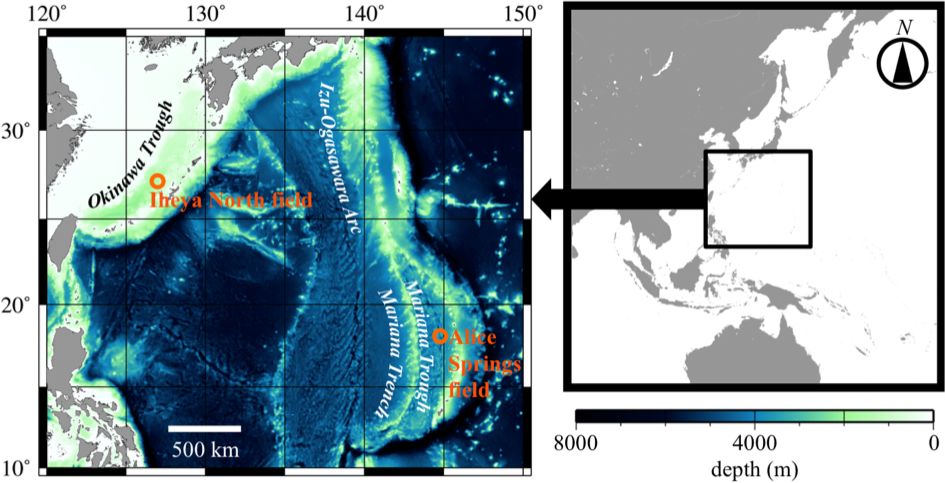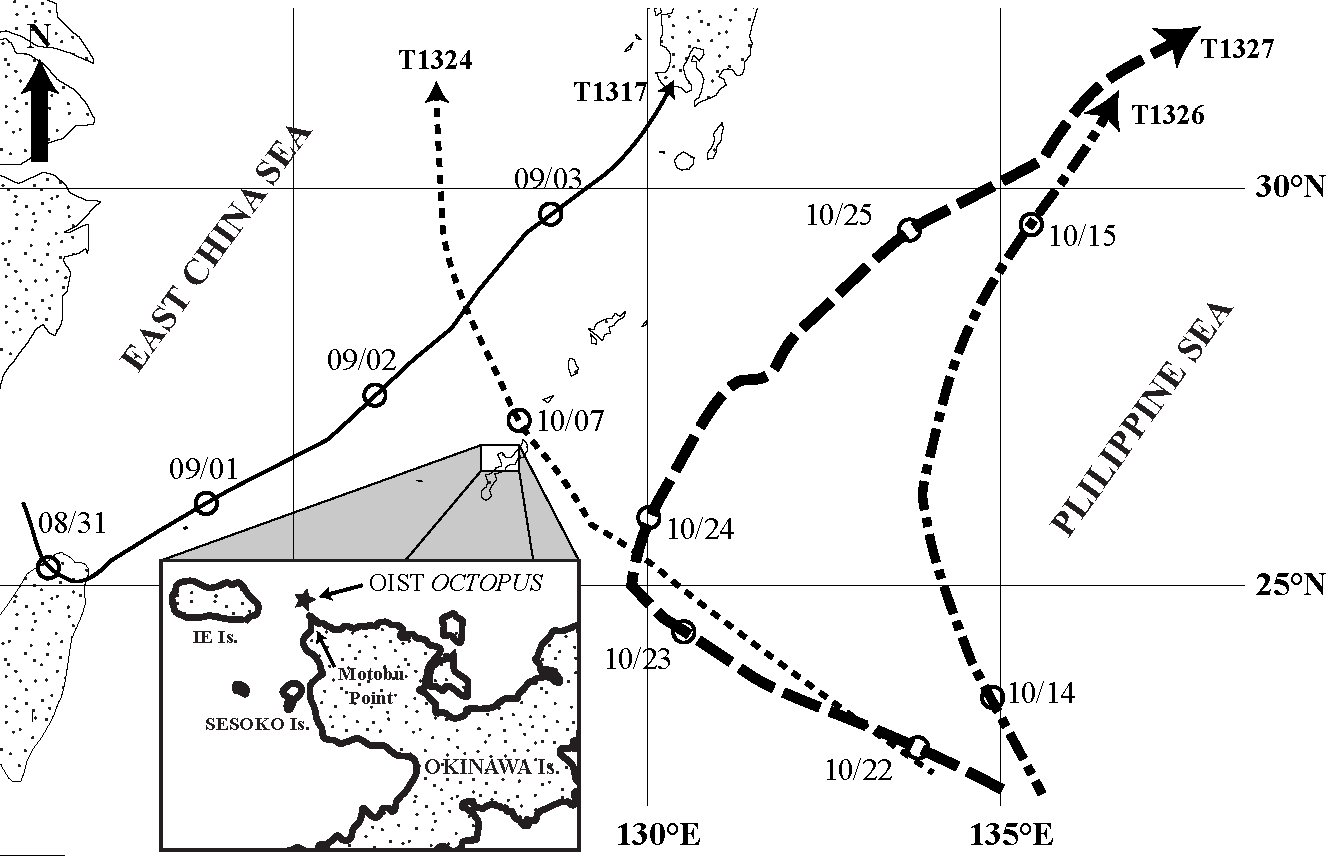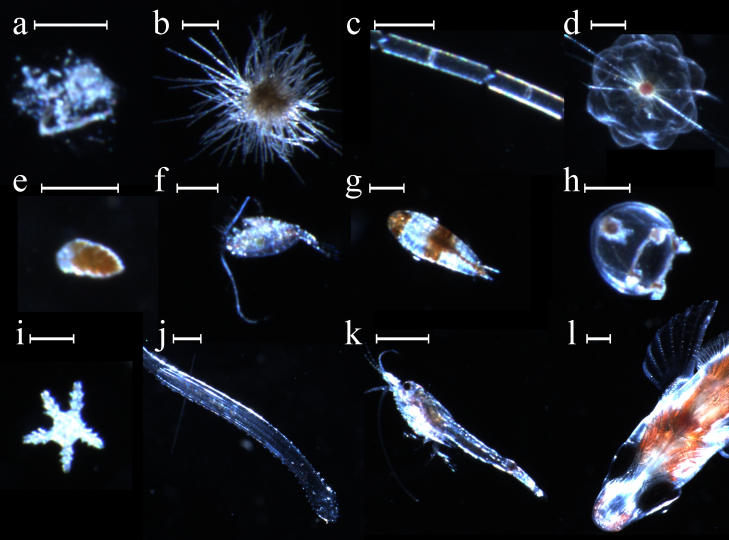FY2014 Annual Report
Marine Biophysics Unit
Assistant Professor Satoshi Mitarai
Abstract
Marine Biophysics Unit will develop forecasting system for the coastal ocean circulation processes around Okinawa and implement a validated connectivity assessment tool, coupling available modeling and observation techniques. This modeling tool will
- Help marine biologists and geneticists estimate rates of geneticists estimate rates of gene flow among sites,
- Enable public agencies to build and evaluate marine protected areas based on population connectivity, and
- Provide marine ecologists with a modeling system for predicting the global and long-term dynamics of the marine ecosystem
Marine Biophysics Unit was established on Sep. 1, 2009 when Satoshi Mitarai joined OIST.
1. Staff
- Satoshi Mitarai, Assistant Professor (September 2009 –)
- Masako Nakamura, Staff Scientist (March 2010 – March 2015)
- Yuichi Nakajima, Postdoctoral Scholar (August 2013 –)
- Mary Matilda Grossmann, Postdoctoral Scholar (October 2013 –)
- Atsushi Fujimura, Postdoctoral Scholar (July 2015 –)
- Yukiko Murabayashi, Technician (July 2011 –)
- Shohei Nakada, Technician (August 2011 –)
- Yuta Nunome, Technician (May 2014 –)
- Takashi Ihara, Technician (April 2015 –)
- Kazumi Inoha, Technician (April 2015 –)
- Yuka Osawa, Technician (July 2015 –)
- Ayumu Migita, Technician (August 2015 –)
- Patricia Wepfer, Graduate Student (January 2015 –)
- Maki Thomas, Graduate Student (September 2015–)
- Margaret Mars Brisbin, Graduate Student (September 2015 –)
- Chihiro Arasaki, Research Administrator (July 2012 –)
Past members
-
Emile Trimoreau, Short-term Student (September 2010–February 2011)
-
Flora Vincent, Short-term Student (July 2011–December 2011)
-
Hirohito Yamazaki, Short-term Student (August 2011–September 2011)
-
Fiona Francis, Internship Student (May 2012–August 2012)
-
MiHye Seo, Internship Student (October 2012–January 2013, July 2013–August 2013)
-
Yuki Kamidaira, Internship Student (August 2013–September 2013)
-
Shizuka Kuda, Research Administrator (February 2010–July 2012)
-
Taichiro Sakagami, Technician (February 2010–August 2013)
-
Daisuke Hasegawa, Postdoctoral Scholar (October 2011–March 2014)
2. Collaborations
- Theme: Larval dispersal of coral reef species
- Type of collaboration: Joint research
- Researchers:
- Prof. K. Sakai, University of the Ryukyus
- Theme: Larval dispersal of hydrothermal vent species
- Type of collaboration: Joint research
- Researchers:
- Dr. T. Maruyama, Japan Agency for Marine-Earth Science and Technology
- Dr. Y. Fujiwara, Japan Agency for Marine-Earth Science and Technology
- Dr. Y. Furushima, Japan Agency for Marine-Earth Science and Technology
- Dr. H. Watanabe, Japan Agency for Marine-Earth Science and Technology
- Theme: Regional ocean circulation modeling
- Type of collaboration: Joint research
- Researchers:
- Prof. J. McWilliams, University of California, Los Angels
- Dr. A. Shchepetkin, University of California, Los Angels
- Prof. Y. Uchiyama, Kobe University
- Dr. E. Gross, Stanford University
- Theme: Okinawa coastal ocean observing system
- Type of research: Joint research
- Researchers:
- Mr. K. Hirate, Okinawa Prefectural Fisheries and Ocean Research Center
- 11th Japan Regional Coast Guard
- Dr. S. Gallager, Woods Hole Oceanographic Institution
- Dr. M. Toda, Okinawa Churaumi Aquarium
- Theme: Study on the mechanisms of chronic abundance and metapopulation connectivity of COTS (Crown-of-Thorns Starfish) along Onna coast
- Type of collaboration: Joint research
- Researchers:
- Dr. K. Fukumra, Okinawa Environment Science Center
- Dr. K. Okaji, Coral Quest Inc.
3. Activities and Findings
Quantification of Connectivity in marine ecosystems
3.1 Genetic connectivity of reef-building corals and deep-sea hydrothermal vent species
Barnacles of the genus Neoverruca are abundant near deep-sea hydrothermal vents of northwestern Pacific Ocean, and are useful for understanding processes of population formation and maintenance of deep-sea vent faunas. Using next-generation sequencing, we isolated 12 polymorphic microsatellite loci from Neoverruca sp., collected in the Okinawa Trough. These microsatellite loci revealed 2–19 alleles per locus. The expected and observed heterozygosities ranged from 0.286 to 1.000 and 0.349 to 0.935, respectively. Cross-species amplification showed that 9 of the 12 loci were successfully amplified for Neoverruca brachylepadoformis in the Mariana Trough. A pairwise FST value calculated using nine loci showed significant genetic differentiation between the two species. Consequently, the microsatellite markers we developed will be useful for further population genetic studies to elucidate genetic diversity, differentiation, classification, and evolutionary processes in the genus Neoverruca.

Fig. 1. Sampling sited for Neoverruca. Iheya North field (for Neoverruca sp.) is located in the Okinawa Trough and the Alice Springs field (N. brachylepadofirmis) is in the Mariana Trough.

Table 1. Characteristics of the 12 developed polymorphic microsatellite loci in 15 individuals of Neoverruca sp. Columns show the locus name, the primer sequence, the repeat motif, the size range of amplification products, including the U19 sequence, numbers of alleles (NA), observed (HO) and expected (HE) heterozygosities, and the index of deviation from Hardy-Weinberg equilibrium (FIS), and GenBank accession number.
3.2 Continuous monitoring of plankton during a series of typhoons
Typhoons are a common feature of summer and autumn months in the East China Sea. These events often promote phytoplankton growth in surface waters as a result of upwelling and transport of nutrients, but their effects on sub-surface waters and ecosystems are little known. Furthermore, biological studies tend to focus on phytoplankton (using chlorophyll a assays), rather than on heterotrophic zooplankton. Indeed, using standard shipboard sampling techniques, measurements of biological and physicochemical changes induced by the storms are difficult to perform and risky. Using a camera mounted on an underwater, cabled observatory system in shallow coastal waters of Okinawa, Japan, we collected the first continuous, in situ observations of the near-bottom mesoplankton community during a series of typhoons. An increase in diatoms and radiolarians was found during all typhoons, whereas the response of larger zooplankton groups was variable between typhoons. A bloom of Trichodesmium cyanobacteria and diatoms was seen after a series of typhoons, while the total chlorophyll a concentration remained nearly unchanged at the sampling location. These findings shed new light on short-term responses of sub-surface ecosystems during typhoons.

Fig. 2. Map of the sampling area showing the position of the OCTOPUS observatory (star), and tracks of the epicenters of the four typhoons studied (data obtained from the Japan Meteorological Agency 2014). Track width indicates relative wind strength of the typhoons. Dates are given in UTC.

Fig. 3. Examples of the 11 CPICS image categories: a marine snow, b Trichodesmium spp., c diatoms, d radiollarians, e foraminiferans, f copepods, g isopods, h cnidarians, "other zooplankton" (i adult starfish, j chaetognath), k mysids, l fish. Scale bar = 500 µm except for j, k, l 1,000µm.

Fig. 4. Temporal variation in abundance (counts/h) of particle and plankton types during the sampling period. Colour scale represnts significant wave height (m), gray shading indicates missing wave height information. White boxes correspond to typhoons.
3.3 Connectivity of the Crown-of-Thorns Starfish around Okinawa
Boom and bust dynamics are a prominent characteristic of the CrownofThorns Starfish (Acanthaster planci) populations. Outbreaking starfish populations damage coral communities extensively and then often disappear quickly. In contrast, Onna village, on the central west coast of Okinawa Island, Japan, has been experiencing chronically high population densities of A. planci for decades. In this study, we examined spatial and temporal population dynamics of A. planci along the coast of Onna village, using removal data gathered over 24 years by a local fisheries sooperative. The results demonstrate that A. planci populations along the Onna coast often experienced high densities prior to 2003, and that recently, populations have again been increasing drastically. Sizefrequency distributions suggest multiple, successive recruitment, as one of the driving factors maintaining A. planci populations in this location. Moreover, within the Onna area, the timing of outbreak peaks varied among the different locations, showing a
northward progression.

Fig. 5. Site maps. a) Okinawa Island, Japan; b) Onna Village, Okinawa; c) Research areas along the Onna coast. AF=Afuso, SR=Seragaki, MO=Minami Onna, MG=Maeganeku, MA=Maeda.

Fig. 6. Densities of Acanthaster planci removed at five areas along the Onna coast from 1998 to 2012.
4. Publications
4.1 Journals
-
Grossmann, M.M., Collins, A.G., and Lindsay, D.J. Description of the eudoxid stages of Lensia havock and Lensia leloupi (Cnidaria: Siphonophora: Calycophorae), with a review of all known Lensia eudoxid bracts. Systematics and Biodiversity 12 (2), 163–180, April 2014.
-
Shinzato, C., Yasuoka, Y., Mungpakdee, S., Arakaki, N., Fujie, M., Nakajima, Y., and Satoh, N. Development of novel, cross-species microsatellite markers for Acropora corals using next-generation sequencing technology. Frontiers in Marine Science 1, 1–5, May 2014.
-
Nakamura, M.*, Watanabe, H., Sasaki, T., Ishibashi, J., Fujikura, K., and Mitarai, S. Life history traits of Lepetodrilus nux in the Okinawa Trough, based upon gametogenesis, shell size, and genetic variability. Marine Ecology Progress Series 505, 119–130, May 2014.
-
Nakajima, Y., Shinzato, C., Khalturina, M., Watanabe, H., Inagaki, F., Satoh, N., and Mitarai, S. Cross-species, amplifiable microsatellite markers for neoverrucid barnacles from deep-sea hydrothermal vents developed using next-generation sequencing. International Journal of Molecular Sciences, 15, 14364–14371, Aug 2014.
-
Nakamura, M., Okaji, K., Higa, Y., Yamakawa, E., Mitarai, S. Spatial and temporal population dynamics of the crown-of-thorns starfish, Acanthaster planci, over a 24-year period along the central west coast of Okinawa Island, Japan. Marine Biology, August 2014, 1432-1793, August 2014.
-
Lindsay, D., Guerrero, E., Grossmann, M., Fuentes, V. Southern Ocean Gelatinous Zooplankton. In: De Broyer C., Koubbi P., Griffiths H.J., Raymond B., Udekem d’Acoz C. d’, et al. (eds.).Biogeographic Atlas of the Southern Ocean. Scientific Committee on Antarctic Research, Cambridge, pp. 266-275, September 2014.
-
Linday, D., Umetsu, M., Grossmann, M. M., Miyake, H., Yamamoto, H. The Gelatinous Macroplankton Community at the Hatoma Knoll Hydrothermal Vent. In: Ishibashi, J-i., Okino, K., Sunamura, M. (Eds.) Subseafloor Biosphere Linked to Hydrothermal Systems, pp 639-666. November 2014.
-
Grossmann, M.M., Gallager, S.M., Mitarai, S. Continuous monitoring of near-bottom mesoplankton communities in the East China Sea during a series of typhoons. Journal of Oceanography, 17:1, 115–124. January 2015.
-
Edmunds, P., Steneck, R., Albright, R., Carpenter, R., Chui, P. Y., Fan, TY., Harii, S., Kitano, H., Kurihara, H., Legendre, L., Mitarai, S., Muko, S., Nozawa, Y., Padillo-Gamino, J., Price, N., Sakai, K., Suzuki, G., vanOppen, MJH., Yarid, A., Gates, RD., Geographic variation in long-term trajectories of change in coral recruitment: a global-to-local perspective, Marine & Freshwater Research. February 2015.
-
Lindsay, D.J., Grossmann, M.M., Nishikawa, J., Bentlage, B., Collins, A.G. DNA barcoding of pelagic cnidarians: current status and future prospects. Bulletin of the Plankton Society of Japan, 62(1): 39–43. February 2015.
-
Nakamura, M., Chen, C., Mitarai, S., Insights into life-history traits of Munidopsis spp. from hydrothermal vent fields in the Okinawa Trough, in comparison with the existing data, Deep-Sea Research I, 100: 48–53. March 2015.
-
Grossmann, M.M., Nishikawa, J., Lindsay, D.J., Diversity and community structure of pelagic cnidarians in the Celebes and Sulu Seas, southeast Asian marginal seas. Deep-Sea Research I, 100: 54–63. March 2015.
4.2 Oral Presentation
-
Nakamura, M., Sakai, K., Hasegawa, D., and Mitarai, S., “Larval recruitment and dispersal processes of acroporid corals in the central Ryukyu Islands”, The 3rd Asia-Pacific Coral Reef Symposium, Pintung, Taiwan, June 22-27, 2014
-
Watanabe, H., Mitarai, S., Kojima, S., Kumagai, H., and Ishibashi, J., “Diversity of deep-sea hydrothermal vent faunas in the western Pacific”, The World Conference on Marine Biodiversity 2014, Qingdao, China, September 2014
-
Mitarai S., “Larval dispersal and metapopulation dynamics of hydrothermal vent species”, Ocean Engineering Forum, Kashiwa, Chiba ( Atmospheric and Ocean Research Institute, University of Tokyo campus), Oct 17, 2014.
-
Mitarai S., “Larval dispersal and metapopulation dynamics of hydrothermal vent species”, 2nd Canon Foundation Symposium, Kamata, Tokyo, July 4, 2014.
-
Grossmann, M. M., Mitarai, S., and Gallager, S. M., “OIST Ocean Cube, a new coastal observatory in Okinawa, Japan”, PICES North Pacific Marine Science Organization meeting, Yeosu, Korea, Oct. 16-26, 2014
-
Nakajima, Y., Shinzato, C., Zayasu, Y., Satoh, N., and Mitarai, S., “Genetic differentiations between types and among sites, and reproductive characteristics of Galaxea fascicularis in the Nansei Islands”, 17th Japanese Coral Reef Society Meeting, Kochi, Japan, Nov. 26-Dec. 2, 2014
4.3 Poster Presentations
-
Grossmann, M.M., Gallager, S.M., Mitarai, S., “Effect of tropical cyclones on near-bottom mesoplankton communities above a coral reef”, Aquatic Sciences Meeting, Granada, February 24, 2015.
-
Nakamura, M., Kumagai, N., Sakai, K., Okaji, K., and Mitarai, S., “Larval recruitment patterns of Crown-of Thorns Starfish and acroporid corals along the Onna coast”, 17th Japanese Coral Reef Society Meeting, Kochi, Japan, Nov. 26-Dec. 2, 2014
-
Nakajima, Y., Iguchi, A., Nishikawa, A., Nagata, T., Uyeno, D., Sakai, K., Mitarai, S., “Genetic diversity and structure of coral Seriatopora hystrix at the Ryukyu archipelago”, 62nd Ecology Society of Japan, Kagoshima, Japan, Mar. 21, 2015
5. Intellectual Property Rights and Other Specific Achievements
External funding
-
Pursuit of Dream Grant, Canon Foundation, “Larval dispersal and metapopulation dynamics of hydrothermal vent species”, Lead PI: S. Mitarai (OIST), Co-PIs: N. Satoh, H. Kitano, T. Maruyama, Y. Fujiwara, Y. Furushima, H. Watanabe (Japan Agency for Marine-Earth Science and Technology), Amount: 38M Yen, Period: Apr 2011–Mar 2014.
-
Grants-in-Aid for Scientific Research C, Japan Society for the Promotion of Science, “Quantification of spatio-temporal variability in recruitment at hydrothermal vents”, Lead PI: M. Nakamura (OIST), Co-PIs: H. Watanabe (Japan Agency for Marine-Earth Science and Technology), T. Sasaki (University of Tokyo), Amount: 4.3M Yen, Period: Apr 2012–Mar 2016.
-
Takara Scientific Grants, “Study on the larval dispersal patterns of Crown-of-Thorns starfish along Onna coast, Okinawa”, Lead PI : M. Nakamura (OIST), Co-PIs: None, Amount: 480K, Period: Jun 2013-May 2015.
-
Grant for investigating study and activity for nature conservation in the Nansei islands/ProNatura Foundation Japan, “Conservation genetic study in multiple scales for reef-building corals inhabit the Nansei Islands”, Lead PI: Y. Nakajima (OIST), Co-PIs: S. Mitarai, C. Shinzato (OIST), Amount: 2.95M Yen, Period: October 2013-September 2015.
-
Grants-in-Aid for Young Scientists B, “Elucidation of dynamics and connectivity of marine species for conservation of coastal ecosystems in the Nansei Islands”, Lead PI: Y. Nakajima (OIST), Amount: 3.4M Yen, Period Apr. 2013-Mar. 2016
- Fuji Film Green Fund, “Study on the larval dispersal patterns of Reef-building corals and Connectivity in the Central Ryukyu islands”, Lead PI: M. Nakamura (OIST), Amount: 2M Yen, Period: Sep. 2014 - Aug. 2015
6. Meetings and Events
6.1 Workshop: Opportunities of Marine Science
- Date: October 29–30, 2014
- Venue: OIST Campus Lab2
- Speaker:
- Dr. David Siegel, University of California, Santa Barbara
- Dr. David Randall, University of British Columbia
- Dr. Christopher Wood, University of British Columbia
- Dr. Stephen Monismith, Stanford University
- Dr. Amatzia Genin, The Hebrew University of Jerusalem, Israel
- Dr. Louis Legendre, Laboratoire d'Océanographie de Villefranche



